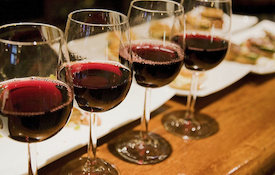How to Taste Wine
There are many aspects to tasting wine. The most important factor is always pleasure. If you don’t enjoy it, what’s the point? You may be presented with a wine that is the critics’ favorite and possibly very expensive. But if you don’t like it, it’s not worth a fraction of the asking price. It is likely that you, as an adult, love foods that you loathed as a child. This is very common and an expected part of your evolution of taste. I am always reluctant to use the tired phrase, “an acquired taste” and would rather see it as a developed taste.

Red Wine Glasses at the Wine Bar
Learning to taste wine is not important in terms of being able to talk with wine experts or to impress your friends. Learning to taste wines and make mental evaluations will allow you to better describe to people what you desire in a wine, allow you to associate one wine with another, to decipher tasting notes reading between the lines to know if they are describing a wine for you, and to identify its general quality, age and condition. All of these are important, as you want to spend your money wisely and with confidence. Above all, this is NOT about making the occasion of drinking and enjoying wine mechanical or a chore. Always default to the most important factor, pleasure. This guide is designed to teach you how to switch on and focus your senses.
Observing Your Wine is King
Learning about wine first starts by switching on your powers of observation. All of your senses are needed and with practice you will find your evaluation skills employing automatically. Don’t worry about getting it right or making a mistake. Sight, smell, and taste are the big three when referring to senses used in tasting wine. However, memory and even emotional cues are very important. The more wines you taste and experience the more important memory becomes in the entire evaluation process. When using sight, smell, and taste you are looking for the following:
- Color and Clarity – Observe the wine’s color. Observing color is very important as it gives you many clues such as age, winemaking, and grape variety. White wines range from very pale with hints of green to deep gold. The palest whites have likely seen no wood aging and have been bottled soon after they were created. Deep gold colors will most often point toward barrel aging and possibly barrel fermentation as well. Copper tones most often lead us to believe that the white wine is older. Red wines show a rather wide color palate. Light, bright ruby red, dark and opaque burgundy, bright purple, brick red, and amber reds moving toward brown are all part of the red wine mosaic. Generally speaking, purple to pinkish hues, and most importantly vibrancy will indicate youth while orange and amber colors indicate age. As your experience grows you will come to associate color with particular varietals but for now learn to connect color with expected aromas.
- The Bridge to Aroma – Now let’s connect your first clues to the second. Pale and bright whites will likely have a very fresh aroma reminiscent of apples, herbs and floral notes, and citrus. In time your mind will automatically expect these types of aromas when that color is observed and anything unexpected will trigger curiosity. Deep, golden colored whites have an expected aroma of wood, perhaps a buttery note, and most of all we expect intensity. Light, bright reds leave us anticipating strawberries, while dark reds indicate cherry, currants, dark berries, and maybe even complex notes of chocolate, brown spices, or pepper (to name just a few).
- Aroma – Aroma is perhaps the most important indicator as your sense of taste is far more than dependent upon what is up in your nasal cavity than it is linked to your tongue. The aromas will further confirm our belief of the wine’s age and will give our best indicator of the grape variety. This will come with building your memory bank of wine aromas. Taking a few seconds to recognize the aromas and associating them with smells that are familiar is all that it takes for your mind to collect this information for use at a further date.
- The Bridge to Flavor – This is the where we put all of our previous observations to good use; this is the payoff. Data on color and aroma are collected and by now our brain has an expected flavor profile built. Much of what we gather in our nose will present itself on the palate when we taste. Now we marry that knowledge with observations of body – is it light and refreshing or intense and brooding?
- Flavor – Finally! We get to taste the wine. Flavor is typically the dominant sensation for the wine drinker and it is certainly why we pull the cork! In most cases, the flavor will greatly echo the aroma. However, the palate reveals many things, most importantly acidity, tannins and body. Balance is discovered on the palate. Does the fruit overpower? Is there ample acidity or perhaps too much? Is there a sense of alcohol strength or sweetness? Also, a balance of flavors (just like a recipe) is vital. The aroma helped us discover many of the wine’s characteristics but are they revealed in balance on the palate? Oh yes, do you like it? At this point you have developed an opinion but by observing and registering the clues you have developed, it is an informed opinion and one that will likely remain in your mind for some time.
